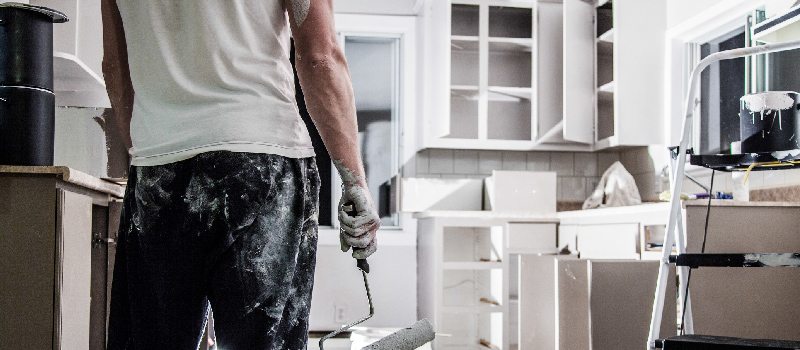
DIY Painting Project? Avoid These Issues This Holiday Season
Promising to paint the house before the holidays kick into high gear is common for many homeowners. The house should look fresh and lovely for the loved ones’ visits. There are a lot of important steps to home painting, however. Choosing a painting contractor might be a better idea. Nevertheless, if you are going to tackle the project yourself you need to avoid these common mistakes before, during and after the work.
1. Wallpaper Etiquette
Looking around at your wallpaper may make you wonder about the best way to paint this room. This decorative accent is essentially thin paper connected to your drywall by way of a strong adhesive. Before you paint, remove the wallpaper whenever possible. You want the textured drywall as your painting surface.
When you hire a home painter, they automatically perform this service. It does take some extra labor, however.
If you have wallpaper that’s difficult to remove, it is possible to paint over it. This method just isn’t the most ideal scenario. Be sure to use an oil-based primer so that the adhesive doesn’t activate once again. You want the paint to roll on and dry without any sticky residue.
2. Respecting Tape Differences
There’s a specific tape for every job around the house. The experts at Cornerstone interior house painting services would advise any DIYer to always choose painter’s tape. Using any other type of tape will negatively impact the final appearance. This tape is designed to perfectly stick to the walls or ceiling as perimeters to your painting area. The edges are sharp, and bleeding under the tape is avoided by pressing it down with a flat tool.
Remove this tape with ease afterward. Masking tape and similar products allow bleeding to occur with residues left on the drywall too. You may even pull the desired paint away from the surface when you use the wrong tape.
3. Prep Confusion
A painting contractor always prioritizes preparation before any color touches the walls. Don’t make the mistake of skipping this step. In fact, it’s a task that should take a good chunk of time.
Preparation involves cleaning the walls of any grease and debris. Find those cracks and fill them. Allow any filler to dry across its allotted time. Using paint as the correction agent in these cases will not work. The blemishes will only come through loud and clear.
Don’t forget to cover furniture with tarps and apply painter’s tape in the necessary areas. Once you pour the paint out, you shouldn’t have to stop with the application until you’re completely done. The prep work actually makes the color application easier and successful.
4. Professional Flair
Hiring a professional painting team, such as Cornerstone Painting from Woodinville WA, will always result in a project with a neat-and-tidy result. As a DIYer, try to emulate their professional flair by following proper application techniques.
Start any paint job at the top of the wall. Any drips that might escape the brush or roller can be quickly blended into the surface afterward.
You may be able to avoid drips altogether by adding just enough paint to the brush or roller. Cover the brush with paint, but only up to about a third of its bristles. Use this same concept for the roller. By adding a moderate amount of paint to the wall, it can be blended without too much being moved around at a single time.
5. Primer Importance
Aside from prepping the area, applying primer is the next essential step. Interior house painting services will never skip this process. In fact, most professionals still recommend that a separate primer from the paint is always better than the newer mixtures today.
The primer goes over the old paint, which creates a new surface for the final color. You want the chosen color to look like those paint samples you brought home. Without the primer in place, the final color will look completely different.
After applying the primer, the wall will be much easier to paint with the final color. These steps are the keys to a professional look in your home.
6. Paint-Finish Neglect
You may be done with the prep work, but there’s an extra step to consider. Take a look at the existing finish on the wall. If it has a shiny appearance, it’s either a semi- or high-gloss finish. These surfaces are slick to the touch even when they’re clean. Applying paint right onto them will be challenging. It may not stick to the surface.
Pull out a sander and give the existing finish a light sanding. You’re trying to rough up the surface so that it has a texture. Any paint added to the sanded surface will now have something to grab onto. Don’t forget to vacuum the sanded surfaces before applying the paint. The sanding action roughs up the surface, but it also produces debris that cannot be painted over.
7. Misunderstanding the New Finish
Those terms, such as eggshell and semi-gloss, refer to the paint’s finish. You can purchase virtually any color in a specific finish in order to meet the demands of the location. For example, you want to wipe down the walls in the kitchen on a regular basis. Applying a flat finish to the area will only create problems. A semi-gloss is the best finish for areas that require regular cleaning. Reserve the flat paint for areas with less traffic, such as a bedroom.
If you’re not sure about the right finish for your project, interior house painting services can help you with the steps. They’ll immediately know which finish to turn to for longevity and functionality.
8. Improper Tools
Don’t make a big mistake with poor-quality tools. The brushes and rollers used on the walls are just as important as the right type of paint. Examine these tools before you even buy them at the store. Quality rollers won’t have any loose materials that might mar the paint job. The brushes should have perfectly arranged bristles with no section out of place.
Match those quality rollers with handles that can take on the project at hand. Metal will last longer than plastic, for example. To avoid concerns over tools, you can always hire a home painter so that the job can be done before the holidays.
9. Cleanup Timing
As a DIYer, completing any job is an achievement. Relaxing is now the priority. However, make sure to prioritize your cleanup session. Act like a painting contractor by saving your tools from being wasted. Excess paint on the rollers or brushes will dry in place. They may not be viable as tools afterward.
Clean the paint from the tools and dry them off. Pour extra paint back into the cans if it’s still useful for other projects. You want to return your tools back to their original form wherever possible.
Follow specific cleanup rules for each item. Some products require paint thinner, whereas other items work well with a dish detergent. You’ll be able to use them once again when you follow the same rules as a professional painter. Contact Cornerstone Painting in Woodinville WA for professional painting quotes. We’re proud to offer top-quality painting services for your interior spaces. Receive a quote today to see your project completed before the holidays. That new color will stand out as a gift to you and your loved ones.
Request Your Quote!

